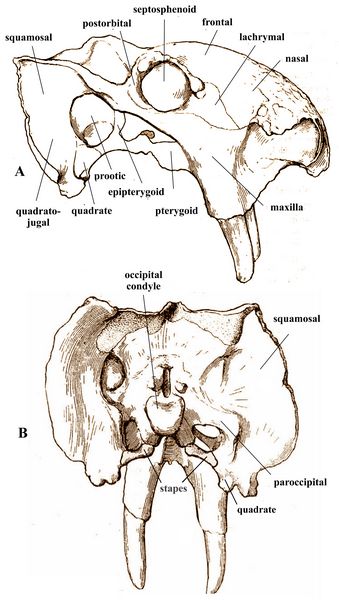Athena Review Image Archive ™
Parakannemeyeria dolichocephala skull

Skull of Parakannemeyeria dolichocephala (after Sun 1980, figs.2 & 4).
Parakannemeyeria dolichocephala was a dicynodon ("two dog tooth") therapsid from the Early to Middle Triassic, (247-240 mya) in northern China. P. dolichocephala was described in 1993 in the Lower Ermaying Formation, from the Ordonian fauna in Shanxi province.
P. dolichocephala had two prominent tusks, which may have been used for digging or rooting for food. Figure B shows a relatively large pair of stapes, part of the middle ear, viewed from underneath the skull.
Parakanneymeria was a close relation to Kannemeyeria, a fossil taxa which is widespread in Pangaea, being found in South Africa, Tanzania, Zambia, Argentina, India, China, and Russia. It always occurs in strata at the boundary of the Early and Middle Triassic (Lucas 1993).
Fossil vertebrates from Ordonian fauna in Shanxi province, for example, consist mainly of these two large dicynodonts, with P. dolichocephala at the top of the section, together with a variety of Kannemeyeria, considered as type species for the Middle Triassic fauna. Kannemeyeria is characterized by a long, narrow, and highly projected parietal crest, as well as tusks of larger dimensions than in the related Parakannemeyeria (Sun 1980).
References:
Lucas,
Spencer G. 1993 Vertebrate biochronology of the
Triassic of China. In Lucas, S.G. and Morales, M. (eds.). The Nonmarine Triassic. New Mexico Museum of Natural History & Science Bulletin. pp. 301–306.
Sun, Ailing 1980 Late Permian and Triassic Terrestial Tetrapods of North China. Vertebrata PalAsiatica Vol XVIII, No.2 April, 1980 pp. 100-110
Copyright © 1996-2020 Rust Family Foundation (All Rights Reserved).